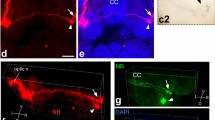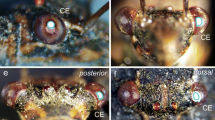Summary
The central origin of efferent neurosecretory fibers (ENSF) supplying the median eyes of the scorpion, Androctonus australis, with circadian information was investigated at the light- and electron-microscopic levels by the use of several tracer techniques. The results obtained convincingly show that the central neurons stained via the optic nerve are the source of the ENSF in the retina. Almost all of these neurons give rise to two different axon collaterals, one of which projects into the ipsilateral, the other into the contralateral median-eye nerve. Three protocerebral contact zones of the ENSF system are described, and their functional role within the circadian clock system is discussed.
Similar content being viewed by others
References
Bacon JP, Altman JS (1977) A silver intensification method for cobalt filled neurones in wholemount preparations. Brain Res 138:359–363
Barlow RB Jr (1983) Crcadian rhythms in the Limulus visual system. J Neurosci 3(4):856–870
Barlow RB Jr, Bolanowski SJ Jr, Brachman ML (1977) Efferent optic nerve fibers mediate circadian rhythms in the Limulus eye. Science 197:86–89
Battelle BA, Evans JA (1982) Efferent fibers to Limulus eyes synthesize and release octopamine. Science 216:1250–1252
Fahren bach WH (1973) The morphology of the Limulus visual system. V. Protocerebral neurosecretion and ocular innervation. Z Zellforsch 144:153–166
Fleissner G (1972) Circadian sensitivity changes in the median eyes of the North African scorpion, Androctonus australis L. In: Wehner R (ed) Information processing in the visual system of arthropods. Springer, Berlin Heidelberg New York, pp 133–139
Fleissner G (1974) Circadiane Adaptation und Schirmpigmentverlagerung in den Sehzellen der Medianaugen von Androctonus australis L. (Buthidae, Scorpiones). J Comp Physiol 91:399–416
Fleissner G (1982) Isolation of an insect circadian clock. J Comp Physiol 149:311–316
Fleissner G (1983) Efferent neurosecretory fibers as pathways for circadian clock signals in the scorpion. Naturwissenschaften 70:366
Fleissner G, Fleissner G (1978) The optic nerve mediates the circadian pigment migration in the median eyes of the scorpion. Comp Biochem Physiol A 61:69–71
Fleissner G, Fleissner G (1985) Neurobiology of a circadian clock in the visual system of scorpions. In: Barth FG (ed) Neurobiology of arachnids. Springer, Berlin Heidelberg New York, pp 351–375
Fleissner G, Fleissner G (1986) Efferent electrical activity — necessary but not sufficient for circadian sensitivity control of the scorpion eyes. Naturwissenschaften (submitted)
Fleissner G, Heinrichs S (1982) Neurosecretory cells in the circadian clock system of the scorpion, Androctonus australis. Cell Tissue Res 224:233–238
Fleissner G, Schliwa M (1977) Neurosecretory fibers in the median eyes of the scorpion Androctonus australis L. Cell Tissue Res 17:189–198
Fuortes MGF, O'Bryan PM (1972) Generator potentials in invertebrate photoreceptors. In: Autrum HJ (ed) Handbook of sensory physiology VII/2. Springer, Berlin Heidelberg New York, pp 279–319
Gregory GE (1980) The Bodian protargol technique. In: Strausfeld NJ, Miller TA (eds) Neuroanatomical techniques: insect nervous system. Springer, Berlin Heidelberg New York, pp 75–95
Heinrichs S (1983) Identification of neurons in the transmission electron microscope after retrograde labelling with the dye Lucifer Yellow. Mikroskopie 40:79–86
Heinrichs S (1985) Differential retrograde labelling with horseradish peroxidase and Lucifer Yellow in an invertebrate nervous system: HRP fluorescence and Lucifer Yellow preservation limit choice of fixative. J Neurosci Methods 15:85–93
Heinrichs S, Fleissner G (1982) Anatomie der efferenten neurosekretorischen Zellen im circadianen Oszillatorsystem des Skorpions. Verh Dtsch Zool Ges, Fischer, Stuttgart, pp 312
Malmgren LT, Olsson Y, Olsson T, Kristensson K (1978) Uptake and retrograde axonal transport of various exogenous macromolecules in normal and crushed hypoglossal nerves. Brain Res 153:477–493
Mancillas JR, Brown MR (1984) Neuropeptide modulation of photosensitivity. I. Presence, distribution, and characterization of a substance P-like peptide in the lateral eye of Limulus. J Neurosci 4 (3):832–846
Mancillas JR, McGinty JF, Selverston AJ, Karten H, Bloom F (1981) Immunocytochemical localization of enkephalin and substance P in retina and eyestalk neurons of the lobster. Nature 293:576–578
Mesulam MM (1982) Principles of horseradish peroxidase neurohistochemistry and their applications for tracing neuronal pathways-axonal transport, enzyme histochemistry, and light microscopic analysis. In: Mesulam MM (ed) Tracing neural connections with HRP. Wiley and Sons, Chichcster-New York, pp 3–135
Nässel DR, Berriman JA, Seyan HS (1981) Cytochrome c as an high resolution marker of neurons for light and electron microscopy. Brain Res 206:439–445
Sanchez JA, Fuentes-Pardo B (1977) Circadian rhythm in the amplitude of the ERG in the isolated eyestalk of the crayfish. Comp Biochem Physiol A 56 (4):601–606
Scharrer B (1972) Neuroendocrine communication-neurohumoral, neurohormonal, and intermediate. Progr Brain Res 38:7–18
Yamashita S, Tatcda H (1978) Spectral sensitivities of the anterior median eyes of the orb web spiders, Argiope bruennichii and A. amoena. J Exp Biol 74:47–57
Yamashita S, Tateda H (1981) Efferent neuronal control in the eyes of orb weaving spiders. J Comp Physiol 143:477–483
Author information
Authors and Affiliations
Additional information
This investigation represents a portion of the Ph. D. thesis of one of the authors (S.H.) and was supported by grants to G.F. from the Deutsche Forschungsgemeinschaft (SFB 45).
Rights and permissions
About this article
Cite this article
Heinrichs, S., Fleissner, G. Neuronal components of the circadian clock in the scorpion, Androctonus australis: Central origin of the efferent neurosecretory elements projecting to the median eyes. Cell Tissue Res. 250, 277–285 (1987). https://doi.org/10.1007/BF00219072
Accepted:
Issue Date:
DOI: https://doi.org/10.1007/BF00219072




